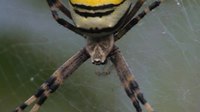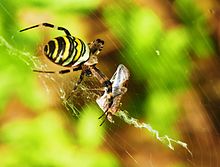Wasp spider
| Wasp spider | ||||||||||||
|---|---|---|---|---|---|---|---|---|---|---|---|---|

Wasp spider ( Argiope bruennichi ) |
||||||||||||
| Systematics | ||||||||||||
|
||||||||||||
| Scientific name | ||||||||||||
| Argiope bruennichi | ||||||||||||
| ( Scopoli , 1772) |
The wasp spider ( Argiope bruennichi ) (also zebra spider , tiger spider or silk ribbon spider) is a spider from the family of real orb web spiders . The large and very strikingly drawn species was voted Spider of the Year in 2001.
description
While males only reach a body length of six millimeters, females are significantly larger with up to 25 millimeters. The yellow and white striped opisthosoma (abdomen), which is drawn like a wasp with black transverse bands , and the silvery-white hairy prosoma (foreleg) are unmistakable in the females . The light brown males with indistinct dark markings are much less conspicuous.
Possible confusion
There is hardly any likelihood of confusion. The closely related species Argiope lobata , which only occurs in the Mediterranean region , also builds nets with a zigzag band and, like A. bruennichi - if undisturbed - always in the middle of the net (the hub), where it has lively black and yellow markings and their roughly same height is just as noticeable. The abdomen of A. lobata is, however, significantly wider than that of A. bruennichi and "lobed", i. H. provided with strong lateral humps. The nets are usually much larger than those of A. bruennichi.
distribution and habitat
Until about 50 years ago the wasp spider was widespread in southern Europe in particular, but very rarely in central Europe; their occurrence here was limited to a few distribution islands in the Upper Rhine Plain , in the Rhine-Main area and in the vicinity of Berlin. Since then, the species has greatly enlarged and expanded its area. It can now be found in almost all European countries as well as in some Asian and North African countries.
The species prefers sunny, open locations with low to half-high vegetation and a high grasshopper population on dry and moist subsoil; z. B. dry grass, gutted wasteland or wet meadows. From May young spiders can be found, from July to August adult animals can be found. The females can be found until October.
Network construction
On average, a wasp spider needs 40 minutes to build a network . The height of the net hub is usually between 20 and 70 cm above the ground. The height is adapted to the habitat of the prey animals. The wasp spider's web is characterized by an often very strong, zigzag-shaped web of webbing in a vertical orientation above and below the hub, the so-called stabiliment. Other forms of stabilization are now known. For example, there are circular arrangements of the zigzag lines around the center of the net (especially with young spiders), only a web of web pointing downwards or even a lack of stabilization. These abnormal or missing stabilizations indicate that the stabilizing effect originally attributed to the network does not primarily apply. The assumption that it is only a kind of camouflage for the network is also considered unsound.
Observations show that the build-up of stability is influenced either by chemical contamination of the habitat or by the age and sex of the wasp spiders. Male spiders predominantly weave the frequent vertical zigzag line above and below the net hub until they reach sexual maturity, but also circular webs of webbing around the central hub. From September to October, the male wasp spiders mostly only seem to weave one-armed, downward-pointing zigzag lines. Female wasp spiders also mainly create the well-known vertical zigzag line, but also circular stabiliments throughout the year. Even combinations of a circular stabilizer and vertical zigzag ribbons have been observed.
nutrition
Due to their habitat, the prey consists mainly of grasshoppers and hymenoptera such as bees and wasps . However, almost all other insects of a suitable size are also captured, such as flies , butterflies , dragonflies or hayhorses . Wasp spiders with a high food supply develop faster, produce more cocoons and disappear much earlier. Conspecifics that eat little go into hibernation very late. As soon as prey is caught in the wasp spider's web, it wraps its victim and kills it with poison. The soft parts of the prey are liquefied by injected poison and then sucked out ( extraintestinal pre-digestion ).
Reproduction
Wasp spiders mate between late July and early August. The male excites the female by characteristic shaking of the net. After the female has risen, the male crawls underneath and mates. Female wasp spiders are, like all females within the genus Argiope , extremely cannibalistic and try to prey on the male immediately after mating begins; this then tries to escape. The bulb used for sperm transmission often breaks off and thus blocks the sexual opening of the female. Although this does not increase the male's chances of survival during copulation, the chances of his fatherhood's success against competing, later copulating males are increased. It is still unclear whether genital mutilation is an adaptation to the sexual cannibalism of females or whether cannibalism represents a female strategy against male "monopoly" by means of constipation of the female genitals.
From the end of August, the females lay their eggs in spherical, brownish cocoons . The young spiders that soon hatch hibernate in the well-camouflaged cocoon. As soon as it is warm enough for them, they leave their cocoons and develop into adult spiders very quickly.
Toxicity
The wasp spider's venom is not dangerous to humans. The venomous claws usually cannot penetrate human skin because they are too short. A poison bite can theoretically only occur on thin areas of skin, such as the earlobes. Swelling, redness and slight pain can result.
Danger
The species is widespread and common in suitable habitats. In Germany it is classified as "safe" in the Red List .
literature
- P. Sacher: Rudimentary nets in adult males of the wasp spider Argiope bruennichi. In: Publ. Naturhist. Mus. Schleusingen. 6, 1991, pp. 30-38.
- Heiko Bellmann : Spinning: observing - determining. Naturbuch Verlag, Augsburg 1992, ISBN 3-89440-064-1 .
- T. Blick (Coord.): Checklist of the spiders of Central Europe. Checklist of the spiders of Central Europe. (Arachnida: Araneae). 2004. Arachnological Society e. V
- PR Harvey, DR Nellist, MG Telfer (Eds.): Provisional atlas of British spiders (Arachnida, Araneae). Volumes 1 & 2. Biological Records Center, Huntingdon 2002.
- T. Kronestedt: Checklist of Spiders (Araneae) in Sweden. Department of Entomology, Swedish Museum of Natural History, Stockholm 2001.
Web links
Argiope bruennichi in the World Spider Catalog
- Wasp spiders (all information about the wasp spider with a large picture gallery)
- Argiope bruennichi at Fauna Europaea. Retrieved August 9, 2013
Individual evidence
- ↑ J. Murphy; British Arachnological Society: World Distribution Map . 2006. British Arachnological Society
- ↑ A. Staudt (coord.); Arages eV: European distribution . 2008. Arages eV
- Jump up ↑ Stefan H. Nessler, Gabriele Uhl, Jutta M. Schneider: Genital damage in the orb-web spider Argiope bruennichi (Araneae: Araneidae) increases paternity success. In: Behavioral Ecology. 18, Issue 1, 2007, pp. 174-181. (Summary) (press release)
- ↑ G. Uhl, SH Nessler, J. Schneider: Copulatory mechanism in a sexually cannibalistic spider with genital mutilation (Araneae: Araneidae: Argiope bruennichi). In: Zoology. (Jena). 110 (5), 2007, pp. 398-408. Epub 2007 Sep 14. PMID 17869076






